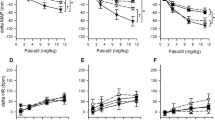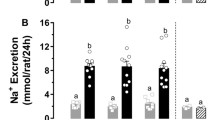Abstract
The influence of common salt (NaCl) and a novel potassium-, magnesium-, and L-lysine-enriched mineral salt on the cardiovascular and renal effects of the selective imidazoline I1-receptor agonist moxonidine was examined in spontaneously hypertensive rats (SHR). Common salt was added at the level of 6% of the dry weight of the chow, and mineral salt at a 75% higher level of 10.5% thereof to produce the same NaCl concentration of 6% as in the common salt group. During the control diet an 8-week oral treatment with moxonidine (117mg/1000g of the dry weight of the chow producing an approximate daily dose of 10mg/kg), lowered blood pressure by 13mmHg. The common salt diet alone raised blood pressure by 27mmHg. Moxonidine lowered blood pressure by 21mmHg during the common salt diet, but the blood pressure remained 19mmHg higher than in the moxonidine-treated SHR receiving the control diet (P<0.05). Unlike common salt, mineral salt alone did not raise blood pressure nor did it interfere with the antihypertensive effect of moxonidine. Moxonidine showed a kidney-protective effect during the control diet measured as decreased urinary protein excretion, but it did not affect the development of left ventricular hypertrophy. Moxonidine increased plasma renin activity during the control diet and it raised the serum aldosterone level both during the control and mineral salt diets. The vascular relaxation responses of the mesenteric arterial rings to both acetylcholine (an indicator of endothelium-dependent vascular relaxation) and nitroprusside and nitroprusside (an indicator of endothelium-independent vascular relaxation) were attenuated by the common salt diet alone but maintained during the moxonidine treatment.
Our findings are consistent with the concept that moxonidine is able to improve the excretion of sodium. This effect might explain the maintenance of normal vascular relaxation during a high intake of common salt. These effects may partly account for the antihypertensive effect of moxonidine.
Similar content being viewed by others
Author information
Authors and Affiliations
Additional information
Received: 10 January 1997 / Accepted: 14 February 1997
Rights and permissions
About this article
Cite this article
Mervaala, E., Malmberg, L., Teräväinen, TL. et al. Influence of different dietary salts on the cardiovascular and renal effects of moxonidine in spontaneously hypertensive rats. Naunyn-Schmiedeberg's Arch Pharmacol 356, 107–114 (1997). https://doi.org/10.1007/PL00005017
Issue Date:
DOI: https://doi.org/10.1007/PL00005017




